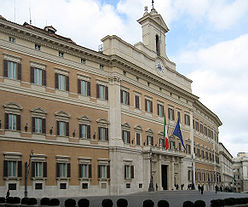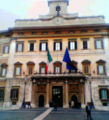- Palazzo Montecitorio
-
Palazzo Montecitorio 
Palazzo Montecitorio, seat of the Italian Chamber of DeputiesGeneral information Town or city Rome Country Italy Coordinates 41°54′05″N 12°28′43″E / 41.901389°N 12.478611°E Design and construction Client Cardinal Ludovico Ludovisi Architect Gian Lorenzo Bernini
Carlo Fontana
Ernesto BasileThe Palazzo Montecitorio (Italian pronunciation: [paˈlatt͡so montetʃiˈtɔːrjo]) is a palace in Rome and the seat of the Italian Chamber of Deputies.
Contents
History
The building was originally designed by Gian Lorenzo Bernini for the young Cardinal Ludovico Ludovisi, nephew of Pope Gregory XV. However, with the death of Gregory XV by 1623, work stopped, and was not restarted until the papacy of Pope Innocent XII (Antonio Pignatelli), when it was completed by the architect Carlo Fontana, who modified Bernini's plan with the addition of a bell gable above the main entrance. The building was designated for public and social functions only due to Innocent XII's firm antinepotism policies which were in contrast to his predecessors.
In 1696 the Curia apostolica (papal law courts) was installed there. Later it was home to the Governatorato di Roma (the city administration during the papal period) and the police headquarters. The excavated obelisk of the Solarium Augusti, now known as the Obelisk of Montecitorio, was installed in front of the palace by Pius VI in 1789.
With the Unification of Italy in 1861 and the transfer of the capital to Rome in 1870, Montecitorio was chosen as the seat of the Chamber of Deputies, after consideration of various possibilities. The former internal courtyard was roofed over and converted into a semi-circular assembly room.
But the original palace was not ideally suited to its new role and it was rebuilt during the early 1900s leaving only the facade intact. The architect, Ernesto Basile, was an exponent of Art nouveau. He added the so-called Transatlantico, the long and impressive salon which surrounds the debating chamber and now acts as the informal centre of Italian politics.
The debating chamber is characterized by numerous decorations in the Art Nouveau style: the impressive canopy of coloured glass (the work of Giovanni Beltrami), the pictorial frieze entitled The Italian People (by Giulio Aristide Sartorio) which surrounds the chamber, the bronze figures flanking the presidential and government benches, and the panels depicting The Glory of the Savoy Dynasty by Davide Calandra.
See also
- Palazzo del Quirinale
- Palazzo Madama
- Palazzo Chigi
- Palazzo della Consulta
Gallery
-
View by Giovanni Paolo Pannini, c. 1747.
External links
Categories:- Buildings and structures completed in 1697
- Palaces in Rome
- Legislative buildings in Europe
- Gian Lorenzo Bernini buildings
- Seats of national legislatures
Wikimedia Foundation. 2010.






